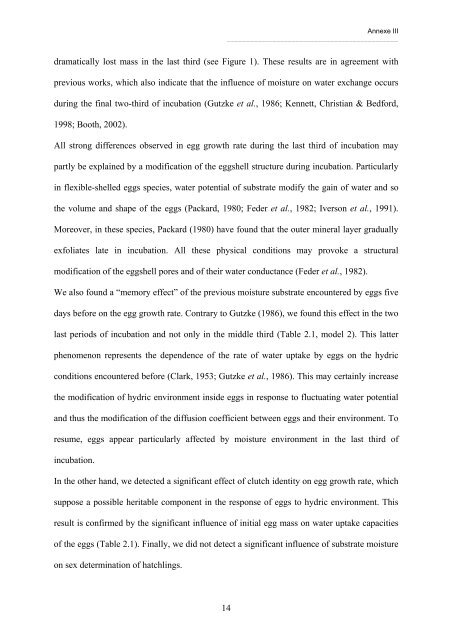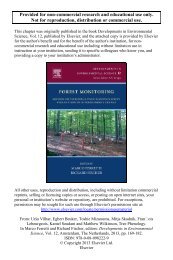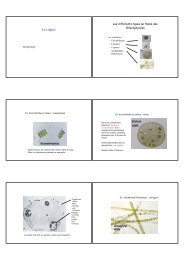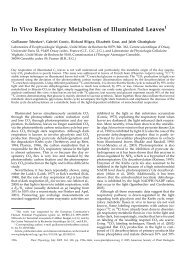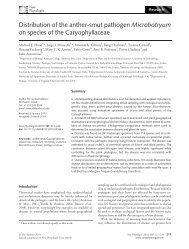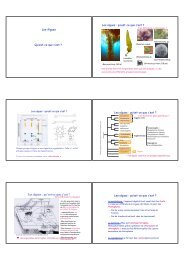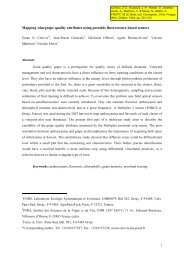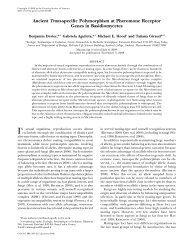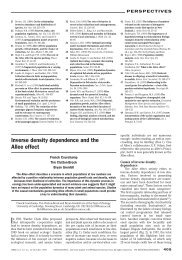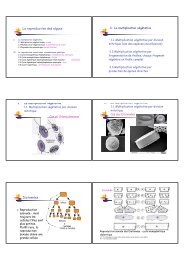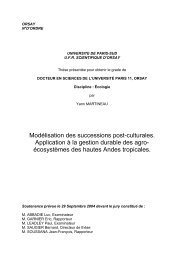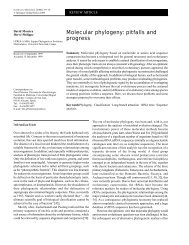Premiers - Outil de Suivi des Contrats
Premiers - Outil de Suivi des Contrats
Premiers - Outil de Suivi des Contrats
You also want an ePaper? Increase the reach of your titles
YUMPU automatically turns print PDFs into web optimized ePapers that Google loves.
Annexe III<br />
_____________________________________________<br />
dramatically lost mass in the last third (see Figure 1). These results are in agreement with<br />
previous works, which also indicate that the influence of moisture on water exchange occurs<br />
during the final two-third of incubation (Gutzke et al., 1986; Kennett, Christian & Bedford,<br />
1998; Booth, 2002).<br />
All strong differences observed in egg growth rate during the last third of incubation may<br />
partly be explained by a modification of the eggshell structure during incubation. Particularly<br />
in flexible-shelled eggs species, water potential of substrate modify the gain of water and so<br />
the volume and shape of the eggs (Packard, 1980; Fe<strong>de</strong>r et al., 1982; Iverson et al., 1991).<br />
Moreover, in these species, Packard (1980) have found that the outer mineral layer gradually<br />
exfoliates late in incubation. All these physical conditions may provoke a structural<br />
modification of the eggshell pores and of their water conductance (Fe<strong>de</strong>r et al., 1982).<br />
We also found a “memory effect” of the previous moisture substrate encountered by eggs five<br />
days before on the egg growth rate. Contrary to Gutzke (1986), we found this effect in the two<br />
last periods of incubation and not only in the middle third (Table 2.1, mo<strong>de</strong>l 2). This latter<br />
phenomenon represents the <strong>de</strong>pen<strong>de</strong>nce of the rate of water uptake by eggs on the hydric<br />
conditions encountered before (Clark, 1953; Gutzke et al., 1986). This may certainly increase<br />
the modification of hydric environment insi<strong>de</strong> eggs in response to fluctuating water potential<br />
and thus the modification of the diffusion coefficient between eggs and their environment. To<br />
resume, eggs appear particularly affected by moisture environment in the last third of<br />
incubation.<br />
In the other hand, we <strong>de</strong>tected a significant effect of clutch i<strong>de</strong>ntity on egg growth rate, which<br />
suppose a possible heritable component in the response of eggs to hydric environment. This<br />
result is confirmed by the significant influence of initial egg mass on water uptake capacities<br />
of the eggs (Table 2.1). Finally, we did not <strong>de</strong>tect a significant influence of substrate moisture<br />
on sex <strong>de</strong>termination of hatchlings.<br />
14


